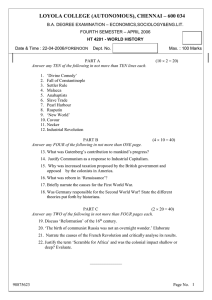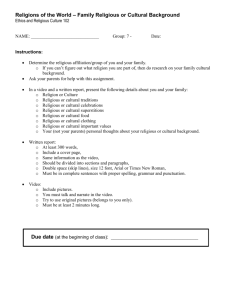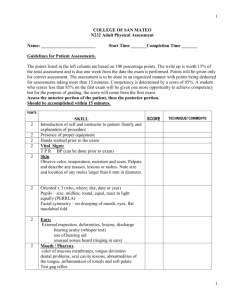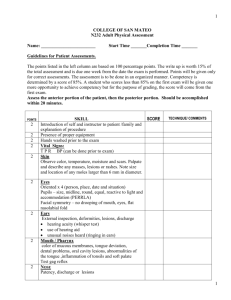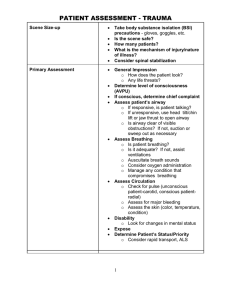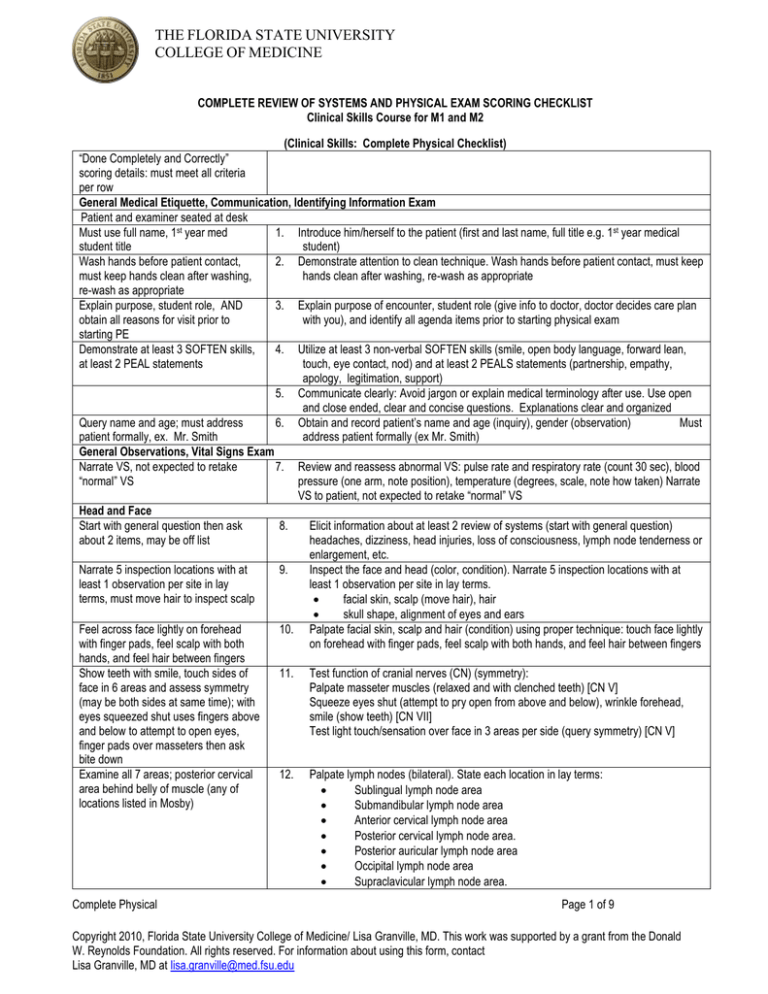
THE FLORIDA STATE UNIVERSITY
COLLEGE OF MEDICINE
COMPLETE REVIEW OF SYSTEMS AND PHYSICAL EXAM SCORING CHECKLIST
Clinical Skills Course for M1 and M2
(Clinical Skills: Complete Physical Checklist)
“Done Completely and Correctly”
scoring details: must meet all criteria
per row
General Medical Etiquette, Communication, Identifying Information Exam
Patient and examiner seated at desk
Must use full name, 1st year med
1. Introduce him/herself to the patient (first and last name, full title e.g. 1st year medical
student title
student)
Wash hands before patient contact,
2. Demonstrate attention to clean technique. Wash hands before patient contact, must keep
must keep hands clean after washing,
hands clean after washing, re-wash as appropriate
re-wash as appropriate
Explain purpose, student role, AND
3. Explain purpose of encounter, student role (give info to doctor, doctor decides care plan
obtain all reasons for visit prior to
with you), and identify all agenda items prior to starting physical exam
starting PE
Demonstrate at least 3 SOFTEN skills,
4. Utilize at least 3 non-verbal SOFTEN skills (smile, open body language, forward lean,
at least 2 PEAL statements
touch, eye contact, nod) and at least 2 PEALS statements (partnership, empathy,
apology, legitimation, support)
5. Communicate clearly: Avoid jargon or explain medical terminology after use. Use open
and close ended, clear and concise questions. Explanations clear and organized
Query name and age; must address
6. Obtain and record patient’s name and age (inquiry), gender (observation)
Must
patient formally, ex. Mr. Smith
address patient formally (ex Mr. Smith)
General Observations, Vital Signs Exam
Narrate VS, not expected to retake
7. Review and reassess abnormal VS: pulse rate and respiratory rate (count 30 sec), blood
“normal” VS
pressure (one arm, note position), temperature (degrees, scale, note how taken) Narrate
VS to patient, not expected to retake “normal” VS
Head and Face
Start with general question then ask
8.
Elicit information about at least 2 review of systems (start with general question)
about 2 items, may be off list
headaches, dizziness, head injuries, loss of consciousness, lymph node tenderness or
enlargement, etc.
Narrate 5 inspection locations with at
9.
Inspect the face and head (color, condition). Narrate 5 inspection locations with at
least 1 observation per site in lay
least 1 observation per site in lay terms.
terms, must move hair to inspect scalp
facial skin, scalp (move hair), hair
skull shape, alignment of eyes and ears
Feel across face lightly on forehead
10. Palpate facial skin, scalp and hair (condition) using proper technique: touch face lightly
with finger pads, feel scalp with both
on forehead with finger pads, feel scalp with both hands, and feel hair between fingers
hands, and feel hair between fingers
Show teeth with smile, touch sides of
11. Test function of cranial nerves (CN) (symmetry):
face in 6 areas and assess symmetry
Palpate masseter muscles (relaxed and with clenched teeth) [CN V]
(may be both sides at same time); with
Squeeze eyes shut (attempt to pry open from above and below), wrinkle forehead,
eyes squeezed shut uses fingers above
smile (show teeth) [CN VII]
and below to attempt to open eyes,
Test light touch/sensation over face in 3 areas per side (query symmetry) [CN V]
finger pads over masseters then ask
bite down
Examine all 7 areas; posterior cervical
12. Palpate lymph nodes (bilateral). State each location in lay terms:
area behind belly of muscle (any of
Sublingual lymph node area
locations listed in Mosby)
Submandibular lymph node area
Anterior cervical lymph node area
Posterior cervical lymph node area.
Posterior auricular lymph node area
Occipital lymph node area
Supraclavicular lymph node area.
Complete Physical
Page 1 of 9
Copyright 2010, Florida State University College of Medicine/ Lisa Granville, MD. This work was supported by a grant from the Donald
W. Reynolds Foundation. All rights reserved. For information about using this form, contact
Lisa Granville, MD at lisa.granville@med.fsu.edu
THE FLORIDA STATE UNIVERSITY
COLLEGE OF MEDICINE
Nose
Start with general question then ask
about 2 items, may be off list
Narrate 2 inspection locations with at
least 1 observation per site in lay
terms, use light
Mouth and Throat
Start with general question then ask
about 2 items, may be off list
Narrate 5 inspection locations with at
least 1 observation per site in lay terms
Use light
Use tongue blade to assist observation
(ex. move buccal mucosa from gingiva)
Observe tongue dorsal, ventral, and
lateral surfaces, use light. Narrate
inspection location with at least 1
observation.
Stick tongue out; bilateral push against
fingers on cheek
Narrate inspection location in general
lay terms with 1 at least 1 observation
(ex I’m looking at the back of your
throat, I see the tonsils do not look
inflamed)
Use light
Eyes
Start with general question then ask
about 2 items, may be off list, include at
least 1 functional item
Hold card 14” away; use corrective
lenses if available
Narrate 5 inspection locations with at
least 1 observation per site in lay
terms; must have patient close eyes to
inspect eyelids; must move eyelids and
have patient look up and down to see
sclera & conjunctiva
Shine light twice in each eye from side
and look in eye illuminated and
opposite eye; accommodation= instruct
patient to look at point on wall and then
close object
Complete Physical
13.
Elicit information about at least 2 review of systems (start with general question) nasal
congestion, nose bleeds, postnasal drip, etc.
14.
Inspect the nares (color, condition); use light. Narrate inspection location with at least
1 observation per site in lay terms.
Nasal mucosa
Nasal septum
15.
16.
17.
Elicit information about at least 2 review of systems (start with general question)
hoarseness, sore throat, bleeding gums, ulcers, tooth problems, dentures, etc.
Inspect 5 areas of the mouth (color, condition); must use light and tongue blade.
Narrate 5 inspection locations with at least 1 observation per site in lay terms.
Buccal mucosa
Gingiva
Teeth
Palate
Sublingual area
Inspect 4 surfaces of tongue (color, condition); must use light. Narrate inspection
location with at least 1 observation.
Test tongue for strength (symmetry) and deviation [CN XII]
18.
Inspect the throat (color, condition); must use light. Narrate inspection location in
general lay terms with at least 1 observation. (ex. I’m looking at the back of the throat,
I can see the tonsils and they do not look inflamed)
Inspect tonsillar pillars/tonsils
Inspect uvula
Inspect posterior pharyngeal wall
Assess palatal elevation (symmetry) with patient saying, “Ah”, state observation [ CN
IX,X]
19.
Elicit information about at least 2 review of systems (start with general question)
blurring, double vision, visual changes, glasses, trauma, eye diseases, dry eyes, etc.
Specifics include at least 1 functional item.
Test visual acuity with Rosenbaum chart: card at 14”, eyes together (with corrective
lenses if available)
Inspect eyes (color, condition, symmetry). Narrate 5 inspection locations with at least 1
observation per site in lay terms.
Eyelids (close eyes), lashes
Sclera (move eyelids, look up and down), conjunctiva (move eyelids, look up and
down), iris
20.
21.
22.
Inspect and test pupils (condition, symmetry) size, shape, light response: direct and
indirect, and accommodation. Shine light twice in each eye from side and look in eye
illuminated and opposite eye; accommodation = instruct patient to look at point on wall
and then close object (6-8 inches away)
Page 2 of 9
Copyright 2010, Florida State University College of Medicine/ Lisa Granville, MD. This work was supported by a grant from the Donald
W. Reynolds Foundation. All rights reserved. For information about using this form, contact
Lisa Granville, MD at lisa.granville@med.fsu.edu
THE FLORIDA STATE UNIVERSITY
COLLEGE OF MEDICINE
Must provide 6 cardinal points of gaze;
guide eye movement from one site to
other without stopping lateral gaze (for
nystagmus) & up to down gaze in
midline (for lid lag)
Hold 1 or 2 fingers in each of 4
quadrants for each eye
23.
Test extraocular eye movements [CN III, IV, VI]; achieve 6 cardinal fields of gaze and
side to side lateral gaze (for nystagmus, with 2 sec pause at each side), up to down
gaze (for lid lag). Guide eye movement from one site to other without stopping
(smooth, continuous movement side to side and up to down)
24.
Test visual fields by confrontation [CN II]: one eye at a time (both examiner and
patient have only the eye opposite each other open); patient asked to identify 1 or 2
extended fingers in each of 4 quadrants
Assessing technique of patient
instruction, room set-up, equipment
hold, and R eye to R eye; L eye to L
eye
25.
Narrate inspection location in general
lay terms with 1 detail (ex. I’m looking
at the back of the eye, blood vessels
can be seen there)
26.
Perform fundoscopy: technique
Ask patient to look straight ahead, start several inches away from and to side of
patient with ophthalmoscope against examiners eye, index finger on diopter wheel,
then moving closer (no more than 3-4 inches away), hold in right hand and use right
eye to examine patient’s right eye, hold in left hand and use left eye to examine
patient’s left eye
Perform fundoscopy: narrate inspection location in general lay terms with 1 detail (I’m
looking at the back of the eye, blood vessels can be seen there)
Inspect for red reflex
Visualize optic disc. Note color of disc and margins.
Visualize retina. Note vessels.
Narrate inspection location in general lay terms with 1 detail
Ears
Start with general question then ask
about 2 items, may be off list, include at
least 1 functional item
Ask patient to close eyes and advise
when sound heard, test one side at a
time
Narrate 4 inspection locations with at
least 1 observation per site in lay terms
(ex. behind ear, outer curve, inner
curve, ear lobe and in front of ear),
must move ear forward and look behind
Examine with finger pads helix,
antihelix; compress lobule between
index finger/thumb; push on tragus
query tenderness
Insert speculum into ear and narrate 2
inspection locations with at least 1
observation per site in lay terms, must
anchor hand holding otoscope
Back And Chest Exam
Patient seated, examiner behind
Start with general question then ask
about 2 items, may be off list
Narrate inspection location with at least
1 observation in lay terms
Complete Physical
27.
28.
Elicit information about at least 2 review of systems (start with general question)
hearing loss, pain, discharge, vertigo, tinnitus, hearing aides, etc. Specifics include at
least 1 functional item.
Test hearing (symmetry) [CN VIII] in each ear using finger rub with patient eyes closed
29.
Inspect bilateral external ear (color, condition, symmetry); must move ear forward and
look behind ear. Narrate 4 inspection locations with at least 1 observation per site in
lay terms.
helix, antihelix, lobule, tragus
30.
Palpate bilateral external ear (color, condition, symmetry):
helix, antihelix, lobule, tragus
Using proper techniques: examine with finger pads helix, antihelix; compress lobule
between index finger and thumb; push on tragus and query tenderness
Otoscopic examination; anchor hand holding otoscope. Narrate 2 inspection locations
with at least 1 observation per site in lay terms.
Inspect ear canals
Inspect tympanic membranes
31.
32.
33.
Elicit information about at least 2 review of systems: (start with general question)
cough, sputum, shortness of breath, dyspnea on exertion, night sweats, exposure to
TB, back pain, etc.
Inspect posterior thorax (color, condition, symmetry, respiratory effort). Narrate
inspection location with at least 1 observation in lay terms
Page 3 of 9
Copyright 2010, Florida State University College of Medicine/ Lisa Granville, MD. This work was supported by a grant from the Donald
W. Reynolds Foundation. All rights reserved. For information about using this form, contact
Lisa Granville, MD at lisa.granville@med.fsu.edu
THE FLORIDA STATE UNIVERSITY
COLLEGE OF MEDICINE
Narrate inspection location with at least
1 observation in lay terms; may
combine with posterior thorax
inspection
Palpate chest expansion with hands
spread across rib cage, thumbs at 10th
rib level
34.
Inspect lateral thorax (color, condition, symmetry, respiratory effort). Narrate
inspection location with at least 1 observation in lay terms
35.
Provide explanation, locate area,
percuss and query tenderness inside;
may percuss over lower ribs or
between ribs and iliac crest
Use side to side approach, 3 levels
(superior lobes to bases, not below
diaphragm or over scapula)
Patient arms crossed
Percuss at 5th intercostal space,
midaxillary line; arms raised
Auscultate after percussion, use side to
side approach; patient arms crossed,
ask patient to breathe deep through
mouth
Auscultate after percussion, use side to
side approach; patient arms crossed,
ask patient to breathe deep through
mouth
Patient seated, examiner in front
Narrate inspection location with at least
1 observation in lay terms
Use side to side approach, 2 levels
over lungs (not heart)
Auscultate after percussion, ask patient
to breathe deep through mouth
Cardiovascular Exam
Patient seated, examiner in front
Start with general question then ask
about 2 items, may be off list
Use diaphragm; patient leaning
forward, then ask exhale and hold
breath, auscultate 3-5 sec
Table at 30 degrees, proper use of
drape, legs supported
Use tangential light
Narrate inspection purpose with at
least 1 observation in lay terms (ex.
looking to see if the neck veins are
enlarged and they are not)
Use bell, ask patient to hold breath,
auscultate 5 sec
Palpate after auscultate
Narrate inspection purpose with at
least 1 observation in lay terms (ex.
looking for heart beat against chest
36.
Palpate chest for chest expansion, note symmetry (place hands on posterior thorax,
thumbs one inch apart at the level of the 10th ribs, hands reaching to the superior and
lateral rib cage and instruct the patient to breathe deeply while observing movement of
entire hand)
Percuss (direct) costo-verterbral angle; provide explanation to patient, with touch
indicate location, provide direct percussion with ulnar aspect of fist, query tenderness
“inside” after each percussion
Complete Physical
37.
38.
39.
Percuss (indirect) posterior chest comparing side to side at 3 different levels; patient
seated with arms crossed in front
Use side to side approach at 3 levels (superior lobes to bases; not below diaphragm or
over scapula)
Percuss (indirect) lateral chest in the axillae comparing side to side at 5th intercostal
space, midaxillary line; patient seated with arms raised in front
Auscultate posterior chest comparing side to side at 3 different levels (superior lobes
to bases) patient seated with arms crossed in front; ask patient to breathe deep
through mouth. Auscultate after percussion.
40.
Auscultate lateral chest in the axillae comparing side to side; patient seated with arms
raised in front; ask patient to breathe deep through mouth. Auscultate after
percussion.
41.
Inspect anterior thorax (color, condition, symmetry, respiratory effort). Narrate
inspection location with at least 1 observation in lay terms
Percuss (indirect) anterior chest comparing side to side at 2 different levels
42.
43.
Auscultate anterior chest comparing side to side at 2 different levels; ask patient to
breathe deep through mouth. Assess 2 levels over lungs (not heart)
44.
Elicit information about at least 2 review of systems: (start with general question) chest
pain, palpitations, number of pillows, edema, claudication, exercise tolerance, etc.
Auscultate heart with diaphragm at left sternal border (3rd or 4th intercostal space),
patient leaning forward, then ask to exhale and hold breath, auscultate 3-5 sec
45.
46.
Patient supine at 30 degrees, examiner on right, use drape, support legs
47.
Inspect lateral neck for jugular venous distension using tangential light. Narrate
inspection purpose with at least 1 observation in lay terms
48.
Auscultate each carotid artery with bell then ask patient to hold breath, auscultate 5
sec
Palpate each carotid pulse (after auscultation, one at a time)
Inspect precordium (note apical impulse). Narrate inspection purpose with at least 1
observation in lay terms
49.
50.
Page 4 of 9
Copyright 2010, Florida State University College of Medicine/ Lisa Granville, MD. This work was supported by a grant from the Donald
W. Reynolds Foundation. All rights reserved. For information about using this form, contact
Lisa Granville, MD at lisa.granville@med.fsu.edu
THE FLORIDA STATE UNIVERSITY
COLLEGE OF MEDICINE
wall, but I don’t see it)
Narrate purpose, state 1 finding in lay
terms (ex. I’m using touch to locate
your heart beat; your heart beat is
strong and regular)
Use diaphragm and bell in all 5
locations, auscultate 5 sec per site
51.
Palpate precordium for PMI. Narrate palpation purpose, state 1 finding in lay terms.
Palpate after inspection.
52.
54.
Auscultate the heart with diaphragm AND bell in 5 locations (5 sec per site):
second right intercostal space (aortic area)
second left intercostal space (pulmonic area)
third left intercostal space (second pulmonic area)
fourth left intercostal space (tricuspid area)
fifth left intercostal space midclavicular line (mitral area)
Adjust table to 0 degrees, patient rolls to left lateral position, left arm away from chest
wall (overhead or out to side)
Palpate apex. Narrate palpation purpose, state 1 finding in lay terms
55.
Auscultate with bell at apex
56.
Patient lying supine with entire abdomen exposed (xiphoid to pubis), examiner on right
57.
Elicit information about at least 2 review of systems: (start with general question) pain,
indigestion, nausea, vomiting, constipation, diarrhea, claudication in legs, etc.
Inspect abdomen (color, condition, symmetry, contour). Narrate inspection location
with at least 1 observation in lay terms
Auscultate (with diaphragm) in 4 quadrants
Auscultate (with bell) for bruits
aorta
renal arteries
femoral arteries (palpate first in clear view)
Superficially palpate entire abdomen in 4 quadrants (1 hand approach). Palpate after
auscultate.
Deeply palpate entire abdomen in 4 quadrants (2 hand approach). Palpate after
auscultate.
Percuss liver (indirect) to identify upper and lower borders of liver and measure liver
span (in cm, with tape measure); percuss from tympanic to dull areas
Palpate for liver edge placing hand below percussed lower border, pushing inward and
upward then asking patient to take deep breath. Palpate after percussion, place hands
in position before patient inhales.
Palpate for spleen (with left hand under and lifting left flank, right hand overlying and
deeply palpating from anterior abdomen then asking patient to take deep breath).
Place hands in position before patient inhales.
Palpate for abdominal aortic pulsation
May move to front of patient if unable
to reach over
Narrate palpation purpose, state 1
finding in lay terms
Use bell
Abdomen Exam
Xiphoid to just above pubis exposed,
chest covered
Start with general question then ask
about 2 items, may be off list
Narrate inspection location with at
least 1 observation in lay terms
Use diaphragm
Use bell, 5 locations
Palpate femoral pulse before
auscultate, palpation performed in
clear view (not under drape)
Palpate entire abdomen in all 4
quadrants (1 hand approach)
Palpate entire abdomen in all 4
quadrants (2 hand approach)
Percuss from tympanic to dull areas
53.
Palpate after percussion, place hands
in position before the patient inhales
64.
Place hands in position before the
patient inhales
65.
58.
59.
60.
61.
62.
63.
66.
Lower Extremities
Patient supine
Start with general question then ask
about 2 items, may be off list, include
at least 1 functional item
Narrate inspection location with at
least 1 observation in lay terms (ex.
Looking at the hips…)
State/explain activity before starting,
span 4-6 inches
Advise patient to relax while examiner
supports leg and moves it into desired
positions; flexion should pass 90
Complete Physical
67.
68.
Elicit information about at least 2 review of systems: (start with general question) joint
pain, muscle pain, swelling, weakness, crepitus, limitation of movement, difficulty with
gait, limping, etc. Specifics include at least 1 functional item (ex. gait problem)
Inspect hips (gross observation of shape over greater trochanters, underwear
present). Narrate inspection location with at least 1 observation in lay terms
69.
Palpate inguinal lymph nodes, explain activity before starting
70.
Examine passive range of motion of hips (Test one side at a time)
Flexion (raise one knee to chest while keeping the other leg straight, pass 90
degree)
Page 5 of 9
Copyright 2010, Florida State University College of Medicine/ Lisa Granville, MD. This work was supported by a grant from the Donald
W. Reynolds Foundation. All rights reserved. For information about using this form, contact
Lisa Granville, MD at lisa.granville@med.fsu.edu
THE FLORIDA STATE UNIVERSITY
COLLEGE OF MEDICINE
degrees
72.
Extension (straighten leg)
External rotation (hip flexion 90 degrees with knee flexion 90 degrees)
Internal rotation (hip flexion 90 degrees with knee flexion 90 degrees)
Advise patient to relax while examiner supports leg and moves it into desired positions;
flexion should pass 90 degrees
Assess muscle strength [hip flexion 90 degrees resists flexion and extension with force
applied above knee (one leg at a time, support lower leg); straight legs resist
abduction and adduction with force applied above ankles (both legs at same time)]
Inspect knees, narrate inspection location with at least 1 observation in lay terms
73.
Palpate knees (patellar motion); explain activity before starting
74.
75.
Patient seated, examiner in front
Inspect knees, narrate inspection location with at least 1 observation in lay terms
76.
Palpate knees (medial and lateral joint spaces, popliteal fossa), test one side at time,
explain activity before starting
Examiner rests hand over knee joint
before movement initiated and for
duration of movement
77.
Test each knee individually, stabilize
proximal to joint
78.
Narrate inspection location in lay terms
noting soles and web spaces with at
least 1 observation in lay terms
(may be done while patient supine)
State/explain activity before starting
79.
Examine active range of motion of knees (with hand over medial and lateral joint
spaces, one leg at a time). Examiner rests hand over knee joint before movement
initiated and for duration of movement
Flexion / extension
Assess muscle strength (90 degrees flexed knee attempts extension against force;
partially extended knee attempts flexion against force applied above ankle) (Test each
knee individually. Use one hand to stabilize the patient’s thigh and the other to provide
resistance)
Inspect ankles and feet (including soles and web spaces), narrate inspection location
with at least 1 observation in lay terms. Examine one leg at a time.
Press finger pads in 2 locations, hold 5
seconds, over dorsum of foot and
distal tibia medial aspect, assess with
light touch
Must be in correct location
Provide clear instructions to elicit
desired movements
81.
Provide clear instructions to elicit
desired movements
Test both ankles at same time
84.
Test flexion, extension each leg (with
lower leg supported);
abduction, adduction both legs
Narrate inspection location with at
least 1 observation in lay terms (ex.
Looking at the knees, I see no
swelling)
State/explain activity before starting,
move patella laterally
Adjust patient position
Narrate inspection location with at
least 1 observation in lay terms (ex.
Looking at the knees, I see no scars)
State/explain activity before starting
(ex. Going to touch knees)
71.
Upper Extremities
Patient seated, examiner in front
Start with general question then ask
about 2 items, may be off list, include
Complete Physical
80.
82.
83.
85.
86.
Palpate ankles and feet (medial and lateral malleolus, Achilles tendon with foot
passively dorsiflexed, metatarsals, MTP joints), explain activity before starting. Using
proper techniques: finger pads palpate full surface of malleoli, travel distance of
Achilles; metatarsals palpated from above and below, MTP joints moved up /down.
Examine one leg at a time.
Palpate for presence of edema over dorsum of foot and distal tibia medial aspect (hold
5 seconds, assess with light touch), explain activity before starting. Examine one leg
at a time.
Palpate dorsalis pedis and posterior tibialis pulses, explain activity before starting
Examine active range of motion of ankles (Test both ankles at the same time)
Dorsiflexion / plantar flexion
Inversion / eversion
Examine active range of motion of toes (Test both feet at the same time)
Flexion / extension
Assess muscle strength at ankle (from neutral position exert dorsiflexion and plantar
flexion) (Test both ankles at same time. Say, “Pull up your feet”, and “Push down”)
Elicit information about at least 2 review of systems: (start with general question) joint
pain, muscle pain, swelling, weakness, cogwheel rigidity, limitation of movement,
Page 6 of 9
Copyright 2010, Florida State University College of Medicine/ Lisa Granville, MD. This work was supported by a grant from the Donald
W. Reynolds Foundation. All rights reserved. For information about using this form, contact
Lisa Granville, MD at lisa.granville@med.fsu.edu
THE FLORIDA STATE UNIVERSITY
COLLEGE OF MEDICINE
at least 1 functional item
Narrate inspection location with at
least 1 observation in lay terms (ex.
Looking at shoulders, I see no scars)
State/explain activity before starting
(ex. Touching shoulders)
Test both shoulders at same time:
details at right
87.
difficulty with grip, etc. Elicit at least 1 functional item (ex. grip strength)
Inspect the shoulders, narrate inspection location with at least 1 observation in lay
terms
88.
Palpate the shoulders (clavicle to acromion, AC joint), explain activity before starting
89.
Examine active range of motion of shoulders (Test both shoulders at same time)
Forward flexion (raise both arms forward, straight up over head)
Extension (lower arms to sides, reversing path of flexion)
Abduction (lift both arms laterally and straight up over head)
Adduction (lower arms to sides, reversing path of abduction)
External rotation (place both arms behind head, elbows out)
Internal rotation (place both arms behind back, elbows out, reach as high as
possible)
Assess muscle strength (90 degrees forward flexion resists upward / downward force
applied on forearms; 90 degrees abduction resists upward / downward force applied
on forearms) (Test both shoulders at the same time)
Inspect elbows; narrate inspection location with at least 1 observation in lay terms
Test both shoulders at same time,
force applied below elbows
90.
Narrate inspection location with at
least 1 observation in lay terms
State/explain activity before starting
91.
92.
Fingers above medial epicondyle
Test both elbows at same time: details
at right
93.
94.
Test each side separately
95.
Narrate inspection location with at
least 1 observation in lay terms; dorsal
and palmar surfaces
State/explain activity before starting,
use bimanual technique for PIP, DIP
Test both wrists at same time
Provide clear instructions that elicit
desired movements
Test both hands at same time
Provide clear instructions that elicit
desired movements
Meets details at right:
Test each wrist separately, stabilize
proximal to joint
Test both hands’ grip at same time
Test each hand paper hold separately
Neurological Exam
Ask about 2 items, may be off list,
include at least 1 functional item
96.
97.
Palpate wrists and MCP, PIP, DIP joints (bimanual technique for PIP, DIP)
98.
Examine active range of motion of wrists, test both wrists at same time
Flexion / hyperextension
99.
Examine active range of motion of fingers, test both hands at same time
Fist formation
Finger abduction
Assess muscle strength at wrists (have patient maintain flexion and hyperextension
while applying opposing force; test each wrist separately), hand grip (squeeze two
fingers and pull away; test both hands at same time), thumb / index finger paper hold
(fingers flexed, thumb presses down on PIP; test one hand at a time)
100.
101.
102.
Sensory function
Provide clear instructions and
demonstration of light touch before
patient performance
Complete Physical
Palpate elbows (olecranon, medial and lateral epicondyles); explain activity before
starting
Palpate epitrochlear lymph nodes. Fingers above medial epicondyle.
Examine active range of motion of elbows (Test both elbows at same time)
Flexion / extension (with elbow fully extended, bend and straighten)
Pronation / supination (elbow flexed at right angle, rotate hand from palm side down
to palm side up)
Assess muscle strength (have patient attempt flexion and extension while applying
opposing force) (Test each side separately, stabilize joint)
Inspect wrists and hands (including dorsal / palmar surfaces); narrate inspection
location with at least 1 observation in lay terms
103.
Elicit information about at least 2 neurological review of systems (start with general
question) loss of consciousness, head injury, seizures, paresthesias, gait difficulty,
etc. Specifics include at least 1 functional item
Query if right or left handed
Evaluate superficial touch (using fingertip or pad), advise patient to close eyes, query
symmetry by comparing perception on both sides
dorsum base of thumb (C6)
dorsum base of index finger (C7)
Page 7 of 9
Copyright 2010, Florida State University College of Medicine/ Lisa Granville, MD. This work was supported by a grant from the Donald
W. Reynolds Foundation. All rights reserved. For information about using this form, contact
Lisa Granville, MD at lisa.granville@med.fsu.edu
THE FLORIDA STATE UNIVERSITY
COLLEGE OF MEDICINE
Provide clear instructions and
demonstration of sharp/dull before
patient performance, use correct
locations
104.
Provide clear instructions and
demonstration of vibration before
patient performance, use correct digits
105.
Provide clear instructions and
demonstration of slight up and down
position before patient performance,
use lateral hold of correct digits
106.
Provide clear instructions before
patient performance
107.
Cerebellar function and proprioception
Provide clear instructions before
108.
patient performance
Provide clear instructions before
patient performance, patient arm
extended
109.
Provide clear instructions before
patient performance
110.
Provide clear instructions before
patient performance
Reflexes
Provide clear instructions and
encourage patient to relax muscles
before testing DTRs
111.
Gait and balance, back exam
Provide clear instructions before
patient performance, patient in correct
position
Provide clear instructions before
Complete Physical
dorsum base of little finger (C8)
medial malleolus (L4)
dorsum base of 2nd toe (L5)
lateral malleolus (S1)
Evaluate sharp/dull sensation (provide demonstration sharp and dull), advise patient
to close eyes, query symmetry by comparing perception on both sides
dorsum base of thumb (C6)
dorsum base of index finger (C7)
dorsum base of little finger (C8)
medial malleolus (L4)
dorsum base of 2nd toe (L5)
lateral malleolus (S1)
Evaluate vibration sense (using 128 Hz tuning fork; provide demonstration of
vibration), advise patient to close eyes, query symmetry by comparing perception on
both sides
MCP of index finger
MTP of great toe
Evaluate position sense (hold digit by lateral aspects in neutral position, then move
digit slightly, 2-5mm; provide demonstration up and down), advise patient to close
eyes, note symmetry. Assess recognition of up and down on each digit
MCP of index finger
MTP of great toe
Evaluate cortical sensory functions; advise patient to close eyes, note symmetry
stereognosis
graphesthesia
Evaluate rapid, rhythmic, alternating movements (patient pats knees with each hand,
alternating palms then back of hands, lifting hands completely off legs, start with
accuracy and then “as fast as possible”; perform one side at a time), note symmetry
Evaluate finger-nose-finger test (patient alternately touches his nose and examiner’s
finger with index finger of one hand, fully extending arm; repeated several times while
the examiner moves his/her finger to different positions; then perform using other
hand); note symmetry.
Evaluate finger to nose test (holding both hands in front, palms up, eyes closed,
patient touches his nose with index finger of one hand and then the other); observe for
pronator drift; note symmetry
Evaluate heel to shin test (patient runs heel of each foot along the anterior shin of
opposite leg, starting near the knee and then down to top of foot); note symmetry
112.
Evaluate deep tendon reflexes (provide up to 3 attempts); note symmetry
biceps (45 degree elbow flexion, digit on biceps tendon)
brachioradialis (hand slightly pronated, extended)
triceps (shoulder abducted <70 degrees, elbow passively flexed 90 degrees)
patellar (foot hanging loosely)
Achilles (hand under ball of foot, passively dorsiflexed 5-10 degrees)
clonus (one hand supports lower leg, other hand under ball of foot, briskly
dorsiflex foot and hold for 3 sec or until clonus stops)
113.
Evaluate Romberg test (patient stands feet touching together, arms at side, eyes open
and then eyes closed for at least 3 sec). Stand next to patient for safety
114.
Evaluate recovery (nudge) test (patient still in Romberg position, eyes closed,
Page 8 of 9
Copyright 2010, Florida State University College of Medicine/ Lisa Granville, MD. This work was supported by a grant from the Donald
W. Reynolds Foundation. All rights reserved. For information about using this form, contact
Lisa Granville, MD at lisa.granville@med.fsu.edu
THE FLORIDA STATE UNIVERSITY
COLLEGE OF MEDICINE
patient performance, patient’s eyes
closed
Provide clear instructions before
patient performance
Provide clear instructions before
patient performance
Provide clear instructions before
patient performance
Provide clear instructions and
demonstration before patient
performance
Appropriately adjust exam position for
balance ability
Provide clear instructions before
patient performance
115.
116.
examiner moves behind and pulls gently backwards using shoulders or sternum);
administer 2 nudges. Stand behind patient for safety
Evaluate ability while sitting in chair to touch left hand to right foot, right hand to left
foot
Evaluate rising from chair without using hands
117.
Evaluate gait with arm swing (walk across room, turn around, and return to starting
point). Perform after chair balance
118. Evaluate tandem (heel-toe) walking; stand next to patient for safety (patient walks
using heel of foot against toe of other foot for 4-5 steps, examiner provides
demonstration with arms at side). Perform after gait with arm swing
119. Evaluate back (balance assessment above determines if conducted standing or sitting
in chair)
Inspect back for color, condition, symmetry
Palpate spinous processes and paraspinous muscles (cervical to lumbar area),
patient upright
Test range of motion for flexion: note curvature of spine AND distance from
fingertips to floor
ORAL PRESENTATION: Ask patient to leave the room and then present your findings.
General Observations, Vital Signs Presentation
Note observation compared to stated
120. Report age comparison, apparent gender, body habitus, consciousness level,
age, reports all 7 items
demeanor, health status, notable characteristics
State PR per min, RR per minute
121. Report pulse rate and respiratory rate (per minute), blood pressure (one arm,
State temp and how taken
position), temperature (degrees, scale, how taken)
State BP (SBP/DBP)
Report at least 1 descriptor
122. Report on appropriate grooming [poor hygiene, lack of concern with appearance]
Patient will be in gown
123. Report on appropriate clothing [inappropriate for season, gender, disheveled]
Report at least 1 descriptor (ex. good
124. Report on eye contact [staring, looking at ground]
eye contact without staring)
Report at least 1 descriptor
125. Report on level of cooperation [indifference, unusual docility, irritability]
Report at least 1 descriptor (ex. no
126. Report on abnormal movement or mannerisms [lack of expression, tremors, increased
abnormal movements such as tremors
or decreased psychomotor activity]
or hand wringing); only stating no
abnormal movements earns
incomplete
SPEECH
Report at least 1 descriptor for 3 of 4
127. Report on voice quality: rate, volume, quality [ nasal, slurred, indistinct], pitch
items (ex. uses inflections, is able to
[monotone]. Report at least 1 descriptor for 3 of 4 items
increase voice volume, speech is not
nasal or slurred, pitch is not monotone)
Report at least 1 descriptor for 2 of 4
128. Report on articulation: pronunciation, fluency, rhythm, ease of expression. Report at
items (ex. proper pronunciation, fluent
least 1 descriptor for 2 of 4 items
speech without stuttering or
hesitations)
PDA EXERCISE
129. Reports PDA information retrieval results (must be complete and accurate for full
credit)
Complete Physical
Page 9 of 9
Copyright 2010, Florida State University College of Medicine/ Lisa Granville, MD. This work was supported by a grant from the Donald
W. Reynolds Foundation. All rights reserved. For information about using this form, contact
Lisa Granville, MD at lisa.granville@med.fsu.edu

